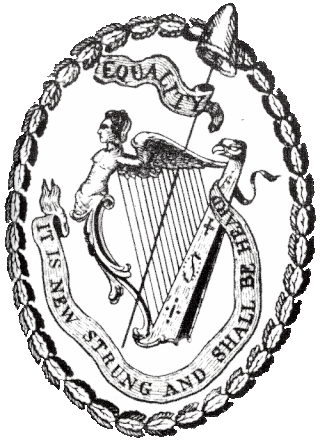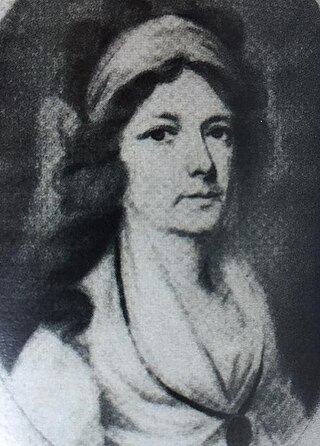
The London Corresponding Society (LCS) was a federation of local reading and debating clubs that in the decade following the French Revolution agitated for the democratic reform of the British Parliament. In contrast to other reform associations of the period, it drew largely upon working men and was itself organised on a formal democratic basis.

Theobald Wolfe Tone, posthumously known as Wolfe Tone, was a revolutionary exponent of Irish independence and is an iconic figure in Irish republicanism. Convinced that so long as his fellow Protestants feared to make common cause with the Catholic majority, the British Crown would continue to govern Ireland in the interest of England and of its client aristocracy, in 1791 Tone helped form the Society of United Irishmen. Although received in the company of a Catholic delegation by the King and his ministers in London, Tone, with other United Irish leaders, despaired of constitutional reform. Fuelled by the popular grievances of rents, tithes and taxes, and driven by martial-law repression, the society developed as an insurrectionary movement. When, in the early summer of 1798, it broke into open rebellion, Tone was in exile soliciting assistance from the French Republic. In October 1798, on his second attempt to land in Ireland with French troops and supplies, he was taken prisoner. Sentenced to be hanged, he died from a reportedly self-inflicted wound.

The Society of United Irishmen was a sworn association, formed in the wake of the French Revolution, to secure representative government in Ireland. Despairing of constitutional reform, and in defiance both of British Crown forces and of Irish sectarian division, in 1798 the United Irishmen instigated a republican rebellion. Their suppression was a prelude to the abolition of the Irish Parliament in Dublin and to Ireland's incorporation in a United Kingdom with Great Britain.

The Irish Rebellion of 1798 was a popular insurrection against the British Crown in what was then the separate, but subordinate, Kingdom of Ireland. The main organising force was the Society of United Irishmen. First formed in Belfast by Presbyterians opposed to the landed Anglican establishment, the Society, despairing of reform, sought to secure a republic through a revolutionary union with the country's Catholic majority. The grievances of a rack-rented tenantry drove recruitment.

William Drennan was an Irish physician and writer who moved the formation in Belfast and Dublin of the Society of United Irishmen. He was the author of the Society's original "test" which, in the cause of representative government, committed "Irishmen of every religious persuasion" to a "brotherhood of affection". Drennan had been active in the Irish Volunteer movement and achieved renown with addresses to the public as his "fellow slaves" and to the British Viceroy urging "full and final" Catholic emancipation. After the suppression of the 1798 Rebellion, he sought to advance democratic reform through his continued journalism and through education. With other United Irish veterans, Drennan founded the Belfast [later the Royal Belfast] Academical Institution. As a poet, he is remembered for his eve-of-rebellion When Erin First Rose (1795) with its reference to Ireland as the "Emerald Isle".

William Sampson was a lawyer and jurist who in his native Ireland, and in later American exile, identified with the cause of democratic reform. In the 1790s, in Belfast and Dublin he associated with United Irishmen, defending them in Crown prosecutions, contributing to their press and, according to government informants, participating on the eve of rebellion in their inner councils. In New York, from 1806 he won renown as a trial lawyer representing the abolitionist Manumission Society and disputing race as a legal disability; challenging the conspiracy charges against organised labor; and, in the name of religious liberty, establishing Catholic auricular confession as privileged. Maintaining that the tradition of common law denied citizens equal access to the law, and was a systematic source of injustice, Sampson pioneered the American codification movement.

Samuel Neilson was an Irish businessman, journalist and politician. He was a founding member of the Society of United Irishmen and the founder of its newspaper, the Northern Star. Along with many other Protestants of Belfast, he was radicalised by the French Revolution. In 1797 he was arrested and the Northern Star suppressed by the Irish authorities. In prison during 1798, he took no part in the failed rebellion of that year. Later he went into exile in the United States, where he died of yellow fever.
Events from the year 1794 in Ireland.
Father James Coigly was a Roman Catholic priest in Ireland active in the republican movement against the British Crown and the kingdom's Protestant Ascendancy. He served the Society of United Irishmen as a mediator in the sectarian Armagh Disturbances and as an envoy both to the government of the French Republic and to radical circles in England with whom he sought to coordinate an insurrection. In June 1798 he was executed in England for treason having been detained as he was about to embark on a return mission to Paris.

Mary Ann McCracken was a social activist and campaigner in Belfast, Ireland, whose extensive correspondence is cited as an important chronicle of her times. Born to a prominent liberal Presbyterian family, she combined entrepreneurship in Belfast's growing textile industry with support for the democratic programme of the United Irishmen; advocacy for women; the organising of relief and education for the poor; and, in a town that was heavily engaged in trans-Atlantic trade, a lifelong commitment to the abolition of slavery. On International Women's Day 2024, a statue of Mary Ann McCracken was unveiled in the grounds of Belfast City Hall.

Charles Hamilton Teeling (1778–1848) was an Irish political activist, journalist, writer, and publisher from Lisburn, County Antrim, Ulster. He was the second son of Luke Teeling a successful Catholic linen merchant who in the cause of complete Catholic Emancipation had been a delegate to the Convention, or "Back Lane Parliament", that had been called by the Catholic Committee in Dublin in December 1792. In 1798, the Teeling mill was to be destroyed by Orangemen.
The Philadelphia Aurora was a newspaper, published six days a week in Philadelphia from 1794 to 1824. The paper was founded by Benjamin Franklin Bache, and was continued as a tri-weekly, after his death from yellow fever in September 1798, as a leading organ of radical republicanism by the Irish-American journalist William Duane.
Robert Simms was an Irish radical, and a founding member in Belfast of the Society of United Irishmen. Opposed to insurrection in the absence of French assistance, he resigned his military commission in the Society on the eve of the 1798 rebellion.

The Shan Van Vocht was the name of a song, dating to the period of the Irish rebellion of 1798 that, once printed, gained notoriety in nineteenth century Ireland as a seditious text. In the 1890s it was adopted as the title of a popular historical novel and of a nationalist magazine, both of which, in the face of the growing sectarian division over Irish Home rule, sought to vindicate the republican legacy of the United Irishmen.

The Catholic Committee was a county association in late 18th-century Ireland that campaigned to relieve Catholics of their civil and political disabilities under the kingdom's Protestant Ascendancy. After their organisation of a national Catholic Convention helped secure repeal of most of the remaining Penal Laws in 1793, the Committee dissolved. Members briefly reconvened the following year when a new British Viceroy, William Fitzwilliam, raised hopes of further reform, including lifting the sacramental bar to Catholics entering the Irish Parliament. When these were dashed by his early recall to London, many who had been mobilized by the Committee and by the Convention, defied their bishops, and joined the United Irishmen as they organised for a republican insurrection.
Henry Haslett was in 1791 a founding member in Belfast of the democratic-revolutionary Society of the United Irishmen, and one of the twelve original proprietors of its Painite newspaper, the Northern Star. He had been representative of a group of merchants in the city who had chafed at the Navigation Acts and other measures enacted under the British Crown that restricted Irish trade and industry. He was released from fourteen months detention just before the Irish Rebellion of 1798 in which he played no role. After the 1800 Acts of Union incorporating Ireland in a United Kingdom with Great Britain, he was again active in the commercial life of Belfast promoting its growth as a port.

Captain Waddell Cunningham was an Irish merchant, prominent in the commercial and civic life of Georgian-era Belfast. As a patron of the Belfast Charitable Society and its Poor House; as a commander of the Volunteer patriot militia; and as a Presbyterian subscriber to the costs of erecting Belfast's first Catholic chapel, in a town much agitated by the American struggle for independence he was seen a friend of reform. But as a land speculator, a slaveholder in the West Indies, and an opponent of immediate Catholic Emancipation, he was at odds with the more democratic elements of the town and surrounding districts who, in the wake of the French Revolution, were to directly challenge the authority of the British Crown and of the landed Protestant Ascendancy

Martha "Matty" McTier was an advocate in Belfast, Ireland for women's health and education, and a supporter of democratic reform. Her correspondence with her brother William Drennan and with other leading United Irishmen documents the political radicalism and tumult of late eighteenth-century Ulster.
Jane "Jenny" Greg (1749–1817) in the 1790s was an Irish republican agitator with connections to radical political circles in England. Although the extent of her activities is unclear, in suppressing the Society of United Irishmen the British commander, General Lake, described Greg as "the most violent creature possible" and as someone who had caused "very great [political] mischief" in her native Belfast.

Robert Tennent (1765–1837) was an Irish physician, merchant and philanthropist in Belfast. Representative of a politically radical Presbyterian current in Ireland, in the years following the Acts of Union he was renowned for his confrontations with the local Tory establishment. Among the numerous civic initiatives with which he was associated, the most lasting proved to be Royal Belfast Academical Institution and what is today the Royal Victoria Hospital, Belfast.














